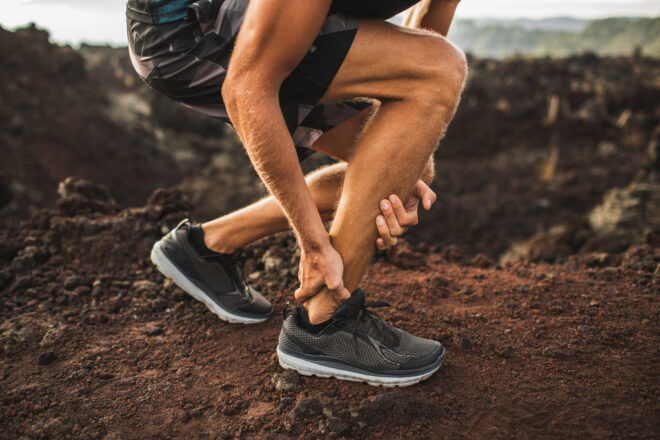When you run, your feet, calves, and legs feel the most impact. Some parts of your body are more at risk than others, and the Achilles tendon is one of them.
In This Article:
What Is the Achilles Tendon?
The Achilles tendon is a fibrous tissue that connects the heel bone with the calf muscles. It’s at the lower end of the calf and the thickest tendon in the body.
Acting as a shock absorber when you’re walking, running, or exercising whenever your foot feels any impact, it’s more prone to injuries, especially considering that the heels and ankles actually have to bear the whole body weight.
When Does the Achilles Tendon Get Injured?
You may not even feel it when you’re running regularly until you start having a lot of pain and inflammation in your heels. Basically, it is an injury that is caused by repetitive stress.
Achilles tendon can get injured due to several reasons, such as:
- Overtraining – when you suddenly increase your speed or time of running, you add stress to your feet and legs, leaving them more vulnerable to damage.
- Changing the surface you are running on – if you move from grass to concrete (or vice versa), your body feels the impact.
- Using incorrect footwear – often, the right running footwear gives better support. If you change your running shoes, you can be at greater risk of pain or damage, especially if you shift to something that does not give you sufficient support.
While Achilles tendon injuries can be treated, it is best to prevent them as much as possible.
What Are the Symptoms of Achilles Tendinitis?
Achilles tendinitis is the most common injury faced by runners. If you experience any of these symptoms, it is best to seek medical advice:
- Pain above the heel
- Reduced range of motion in the ankle and heel
- Swelling in the area
- Pain at the back of the heel
Don’t ignore any kind of pain that you haven’t felt before. If untreated, the tendonitis can worsen. If you experience some sort of pop, your Achilles tendon may have suffered a rupture, and that may need surgical treatment.
How Is Achilles Tendinitis Treated?
Firstly, when you feel any pain that should not be there, you shouldn’t continue any activities you were doing prior to feeling the pain, especially deciding to run till you feel better. Typical conservative treatment helps for quick recovery and includes the following approaches:
- Rest
- Icing the area to reduce inflammation
- Using a crepe bandage to support the tendon
- Elevation, so that blood pooling is reduced
- Using a surgical strap or ankle support
- Doing stretches of your calves and legs even when lying down (if possible)
- Taking anti-inflammatory medicine like ibuprofen or aspirin to reduce pain and swelling
- Using a splint at night to keep the tendon relatively immobile
Your doctor may advise that you use inserts or heel lifts to take the pressure off the tendon while it’s healing. Don’t run again till you get medical clearance to do so.
Can You Do Anything to Prevent Achilles Tendinitis?
While there are special procedures meant for treating the pain, it’s always best to prevent it in advance.
Some preventive steps that you can follow:
- Do warm-up and cool-down exercises before running to increase flexibility and prepare your body for running.
- Strength exercises improve your core strength and help prevent lower back, feet, and ankle injuries. Focus on your calf muscles, more specifically, to help prevent Achilles tendinitis.
- Ensure that you’re using the correct footwear that gives your feet and legs adequate support.
- Eat food rich in protein, vitamin D, calcium, and magnesium to ward off any physical problems.
- Rest if you are unwell or take rest days in-between your workouts regularly. The recommendation is 2 days per week when you can do some other sport or just go for a walk.
While it’s good to push yourself to do your best, don’t let that overtake your good sense – listen to your body first and foremost.
Key takeaways:
- The Achilles tendon is prone to injuries under certain conditions, especially running.
- You are at risk of Achilles tendonitis if there’s any change in running pattern, surface, or footwear.
- Take the recommended treatment – whether you treat it at home or go to a doctor. Implement rest, ice, compression, and elevation as an initial treatment.
- Prevention is key – do your warm-up and cool-down routines, stretches, and strengthening exercises, so you don’t suffer injuries in the first place.
References:
- Ahmed, I.M., Lagopoulos, M., McConnell, P., Soames, R.W. and Sefton, G.K., 1998. Blood supply of the Achilles tendon. Journal of orthopaedic research, 16(5), pp.591-596.
- Milz, S., Rufai, A., Buettner, A., Putz, R., Ralphs, J.R. and Benjamin, M., 2002. Three‐dimensional reconstructions of the Achilles tendon insertion in man. Journal of anatomy, 200(2), pp.145-152.
- Cetti, R., Henriksen, L.O. and Jacobsen, K.S., 1994. A New Treatment of Ruptured Achilles Tendons A Prospective Randomized Study. Clinical Orthopaedics and Related Research (1976-2007), 308, pp.155-165.
- Longo, U.G., Ramamurthy, C., Denaro, V. and Maffulli, N., 2008. Minimally invasive stripping for chronic Achilles tendinopathy. Disability and rehabilitation, 30(20-22), pp.1709-1713.
- Theobald, P., Benjamin, M., Nokes, L. and Pugh, N., 2005. Review of the vascularisation of the human Achilles tendon. Injury, 36(11), pp.1267-1272.














